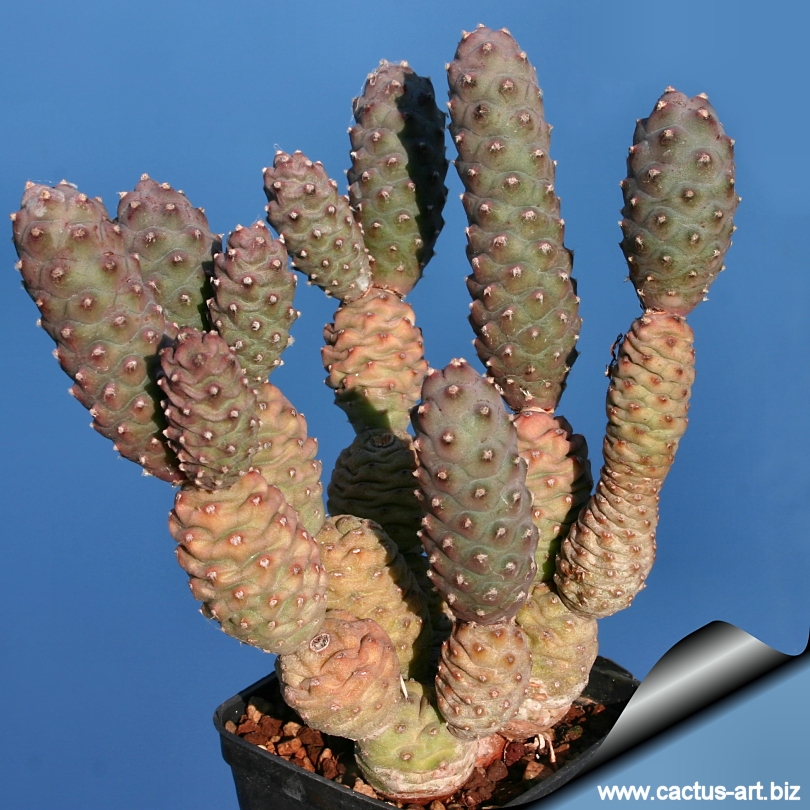|
|
|

Tephrocactus articulatus var. diadematus 'inermis'
Cool looking pine-cone-like plant without spines and irritating
glochids.
|
|
Cultivation:
This is one of the easiest and safest cactus to grown. It is very heat
tolerant and doesn't need shade in summer. It is easy to grow but
usually couldn’t get very tall as segment kept falling apart. It is
fairly cold resistant and hardy to -9°C depending on the clone, Need
full sun, (with insufficient illumination stems get thinner as a result
of the lack of sun) The main growing period is spring. It might produce
some new segments in the autumn too. Needs good drainage.
With plenty of water in summer grows a
lot faster... Keep dry in winter but tolerates long, wet, sloggy, cold
winters.
|
|


Advertising
|
|
|
|
|
Family:
Cactaceae (Cactus
Family)
Tephrocactus diadematus (Lem.)
Lem.
In: Cact: 88. 1868
Accepted
Scientific Name:
Tephrocactus articulatus (Pfeiff.)
Backeb. 1953 (
Distribution: Western
Argentina. It has also been referred to Brazil and Chile, but surely not
found in Brazil and almost surely it does not inhabit Chile too.
Habitat: Dry hills
Vernacular name: Pine Cone Cactus,
Spruce Cone Cholla.
|
Synonyms:
-
Opuntia diademata Lem. 1838
-
Tephrocactus articulatus var. diadematus
Lem.
-
Cereus articulatus Pfeiff. 1837
-
Opuntia articulata (Pfeiff.) D.R.Hunt 1987
-
Opuntia turpinii Lem.
-
Opuntia turpinii polymorpha
Salm-Dick.
In: Cact. Hort. Dick. 1849. 71 1850
-
Opuntia polymorpha
Pfeiff.
In: Enum: Cact. 103. 1837
-
Tephrocactus turpinii
(Lem.) Lem.
In: Cact:
88. 1868
-
Opuntia strobiliformis
A.Berger 1929
-
Tephrocactus strobiliformis
(A.Berger) Fric
1933
|
|
|
|
Description: Succulent upright shrub, up to 60 cm, 1.2 m spread. The
'inermis' form of this species-variety is a nearly spineless form of the
species with no spines and without (or with very few) glochids on the
new growth. These usually fall off as it ages.
Stem: It produces dull greyish-brown to earth-tone coloured
pine-cone-like globular to elongated stem segments 2 to7 cm long. the
segment are hardly tuberculate (except in drying) and generally grow
longer and narrower than var. papyracanthus. The segments usually grow
one or two new segments each year from the stem tips.
Areoles: Large
Spines: The typical form has flattened papery spines 2 to 5(-10)
cm long and numerose reddish-brown glochids (both absent in variety "inermis")
Flowers: Yellowish-white fading to pink.
Blooming season: Spring.
Fruit: Globose, 1 to 1,5 cm long, dry.
Seed: Corky.
|
|
Propagation: Cuttings
(or occasionally seeds) it suckers
profusely and is very easy to grow by just knocking off one of the
'cones' and stuffing it in the ground.
Photo of conspecific taxa, varieties, forms and
cultivars ofTephrocactus articulatus.
|
|